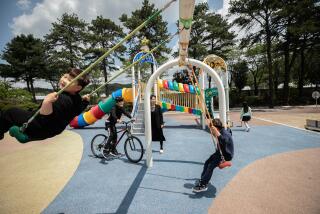Lawndale Pilot Program to Open School Doors for Latchkey Children
- Share via
LAWNDALE — Lots of children at a Lawndale elementary school will be kept after classes beginning in February. But their parents won’t be upset.
The children will be kept after school not as punishment, but as part of what is believed to be the first day-care program at a public school in Los Angeles County.
The pilot program is a joint effort by the Lawndale Department of Leisure and Social Services, the Lawndale Elementary School District and the United Way to tackle the problems of “latchkey” children--youngsters left unsupervised until working parents return home.
District Supt. Jim Waters said his staff is reviewing the results of a survey sent home with children two weeks ago to determine which of its seven schools will start caring for the children before and after classes, from 6:30 a.m. to 6 p.m. The location is expected to be selected later this
$40 Per Child
Monthly fees for the nonprofit, self-supporting program will be $40 per child or $50 per family for after-school care. Before-school fees will be $25 per child or $30 per family.
The Lawndale City Council this week instructed its staff to set up a similar program that would operate when school is not in session.
Brady Cherry, director of Leisure and Social Services, said the city’s program will probably be patterned after its summer day camp. He said he is still looking into state licensing and liability insurance.
The school district’s program will assume liability.
Cherry said monthly fees will probably be double what the school district charges because the children would be cared for all day.
Still, the prices are about half of what is charged at private day-care facilities, said Judy Brandlin, co-chairwoman of United Way’s Los Angeles Western Region task force on school-age child care.
“The average cost per child countywide is about $120 per month for after-school care,” Brandlin said, adding that even at such a steep price, there is still a shortage of day-care facilities for school-age children.
“There is a real need for affordable, quality child care.”
Brandlin said that a study by the Wellesley College Center for Research on Women in Massachusetts found that 70% of all mothers with children under 14 are in the labor force. She said the study found that unsupervised children are more susceptible to accidents or abuse, and that the lack of adult supervision often contributes to poor academic performance and delinquent behavior.
Small Size
Lawndale was chosen for the pilot program because of its small size and the fact that it has no day-care centers for school-age children, Brandlin said.
Cherry said it is not known how many latchkey children there are in Lawndale. He said a special telephone number was set up last month for youngsters to call if they grew lonely or bored, and in the first two weeks more than 250 children responded.
While combining day care and education is new to public schools, parochial schools have had extended school-day programs for the past three years.
The Roman Catholic Archdiocese of Los Angeles provides the care at one of its 250 elementary schools.
Beginning in January, 40 schools from Ventura to Azusa--including one in Redondo Beach--will offer the program.
“They have grown because of the tremendous need,” said Kathy Haugh, the archdiocese’s program administrator.
She said the programs have become an extension of the schools’ learning process.
“This is not baby-sitting,” Haugh said. “There is time for supervised play, time for homework or quiet time. After that, they can do arts and crafts, games or other activities.
“A side benefit that we have found is that when the parents pick them up, their children’s homework is already done. That means the time parents spend with their children is quality time.
‘Parents Love It’
“The parents love it, the children love it, and for school administrators, it takes a lot off their minds not having to watch (unsupervised children) on the playgrounds.”
Haugh said it is time for public schools to offer a similar program.
“Somebody has got to help with the children; somebody has to take that responsibility,” she said. “The school is already there, and why not take advantage of the situation?”
More to Read
Sign up for Essential California
The most important California stories and recommendations in your inbox every morning.
You may occasionally receive promotional content from the Los Angeles Times.













